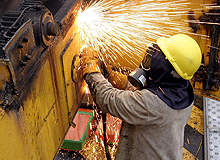
The nuclear decommissioning market is by any estimate huge – expected to reach over €1,500 billion globally by 2035 -a figure that could grow even larger if current trends towards clean energy continue.
This demand should peak over the next 10 to 15 years, and will be largest in a handful of countries, particularly Canada, France, Germany, Japan, Russia, UK and the USA. However, all the 500 plus nuclear plants now in operation or being built around the world will eventually need demolishing, decontaminating and decommissioning.
Left to themselves, most nuclear plants would take more than 100 years before allowing release for unrestricted use. Most of the metal can be recycled, but some will have been irradiated. The great majority of waste (around 97% by volume) is low- and intermediate-level (LLW and ILW), and mainly disposed of in near-surface repositories – often, the same ones that take the waste that is produced continuously by the plant during operation.
The options
The International Atomic Energy Agency (IAEA) has defined three options for decommissioning. Immediate dismantling decontaminates and removes at least part of the plant within a few months or years after closure, so releasing this land for other use. Safe enclosure places the facility into safe storage until radioactive levels have decayed (perhaps 50 or 100 years) before dismantling and decontamination. Entombment encases any radioactive material in steel and concrete without ever completely removing it.
The first two options are by far the most common. They are often combined, with some parts of a facility dismantled or decontaminated while others are left in safe enclosure. The option to take depends on factors like the relative costs, what level the radioactive sources will decay to, and whether waste disposal sites are available. Worldwide, relatively few plants have yet been completely decommissioned and dismantled. More have been or are being partly dismantled and enclosed.
See Also:
A decommissioning timeline
Specific requirements of course depend on the country of location but are broadly divided into initial activities, decommissioning / storage itself, and license termination. The US procedure provides a typical example.
How well do you really know your competitors?
Access the most comprehensive Company Profiles on the market, powered by GlobalData. Save hours of research. Gain competitive edge.

Thank you!
Your download email will arrive shortly
Not ready to buy yet? Download a free sample
We are confident about the unique quality of our Company Profiles. However, we want you to make the most beneficial decision for your business, so we offer a free sample that you can download by submitting the below form
By GlobalDataLicensees in the US must first submit a certification to the Nuclear Regulatory Commission (NRC) notifying that the plant will close, and another when the nuclear fuel is removed from the reactor vessel. A Post-Shutdown Decommissioning Activities Report describes the scheduling and expected costs. The NRC does some public consultation, and owners can start decommissioning after 90 days.
Decommissioning itself normally starts with removing the spent fuel (usually accounting for around 99% of the total radioactivity), which can be stored on site until the DoE removes it to a national repository. Depending on the type of decommissioning, the turbine hall and reactor buildings are dismantled and demolished. Contaminated materials are cleaned on site or cut away and removed for processing, storage, or disposal.
Contaminated equipment can include the reactor vessel, radiation shield, primary loop and steam generators along with large piping systems, pumps and valves. Some older plants had graphite moderator blocks, which after pre-processing can be oxidised and released as CO2, but are more easily buried or recycled into new nuclear products. Cooling towers are demolished, cooling ponds are drained, cleaned and filled in. Any surface contamination is cleaned or removed and, finally, the site is levelled and landscaped.
A Licence Termination Plan (LTP) must be submitted within two years of the expected license termination. Among other things, this identifies the remaining materials to be dismantled, any required radiation surveys and site remediation, and the estimated decommissioning costs. Finally, the NRC issues a letter terminating the operating license. The land may be freed for restricted use, to exclude (for example) parks or farmland. If residual radiation is below 25 millirem/year (0.25 millisievert) exposure, the land may be freed for unrestricted use. At that point, the monitoring and surveillance operations that must accompany all nuclear power activities can be ended.
Decommissioning can be relatively fast, as with the Shippingport reactor in the US which took only two years to defuel and another five years to release the site for other use. Materials can be stored for short (say 5 to 10), medium (10 to 30 years) or long periods depending on the radioactivity levels. Some parts of a site may be released early. Others (like at Spain’s Vandellós-1 site) are planned for 30 years’ safe enclosure before dismantling. When one unit of a multi-unit power station is closed, it is usually placed in storage until the others are also ready to be decommissioned. In France, for example, reactors at Chinon, Bugey and St Laurent have been partially dismantled, with final demolition postponed for 50 years.
The expertise
Special recycling plants may be built like that at Marcoule, France, which can recycle the metal for other nuclear plants. Non-nuclear techniques may be adapted if workers are protected from being exposed to, inhaling or ingesting radiation. That will need techniques like shielding and ventilation, underwater working, mechanical or thermal cutting and sawing, treating, preconditioning waste, remote control and worker and environmental protection.
Utilities are increasingly using specialist contractors. In an attempt to speed up decommissioning in the US, for example, the operator Exelon at the Zion nuclear plant near Chicago transferred the plant’s ownership, licence and decommissioning funds directly to the contractor, EnergySolutions. This set up a subsidiary ZionSolutions for cleanup and environmental restoration, which will return the site and licence to Exelon in about 2018.
EnergySolutions is disposing of all the low-level radioactive waste at its Clive Utah facility. That is located at a remote, desert site 80 miles west of Salt Lake City. This is set away from geologic fault lines, and has less than 8in of annual rainfall, with very salty ground water that is therefore not used by the surrounding communities. Eventually, spent nuclear fuel from Zion will be disposed in a national geologic repository like the proposed Yucca Mountain site in Nevada.
In the UK, similarly, redundant plants and buildings at the old UKAEA Springfields Nuclear Fuels Laboratories are being decommissioned by Westinghouse. This has formed a new company – Springfields Fuels Limited – to handle it all, and is leasing the Springfields site from the UK’s Nuclear Decommissioning Authority (NDA). Solid low-level wastes are disposed of in a 120ha repository at Drigg in Cumbria, near Sellafield. Intermediate waste is being temporarily stored at Sellafield and other sites. High level wastes are also stored and vitrified at Sellafield. Sellafield has recently started commissioning a Product and Residue Store, and according to Stuart MacVean, Sellafield’s Director of Spent Fuel Management, has received its first consignment of material for storage.
Waste problem
The World Nuclear Association reports that 12,000t of high-level waste (HLW) is being produced a year, and mainly stored in interim storage facilities. Although the most radioactive materials by definition have the shortest half lives, some nuclear waste will need to be isolated for thousands of years. The idea is to encase it in stable ceramic material, encapsulate it, and dispose of it in long-term deep geological sites – buried at a depth that hopefully prevents any discharge over that time.
The UK is now studying geologic disposal of waste, and John Dalton, the NDA’s Head of Communications, remarks that the NDA is looking at three different geological environments, higher strength rock, lower strength rock and evaporates (sedimentary rocks).
Such sites need techniques like seismic probabilistic risk assessment (SPRA). Westinghouse has recently teamed with Stevenson & Associates in the US to develop more robust seismic hazard models and curves. Doug Holderbaum, Director of Westinghouse Engineering Services Systems and Risk Applications, believes this will help improve hazard curves and their impact on seismic design margins and probabilistic risk assessments.
The costs of cleaning up
Total cleanup costs depend on factors like plant size and design, the decommissioning option being taken, how long waste is stored, where the facility is located, local labour costs, and costs of radioactive waste burial. Postponing decommissioning reduces the radioactivity and so the dismantling costs but increases storage and surveillance costs. Overall costs depend strongly on the volume of waste to be disposed of, but this can be reduced by using techniques like surface decontamination, compaction and segmentation.
A 2003 OECD survey reported that most reactors cost from around $200 to $500/kWe to decommission. The exception is for gas-cooled reactors like the UK’s Magnox types, which have much more material to dispose of, and can cost above $2,600/kWe. Other estimates place the average cost of decommissioning a large power plant at between $100m and $200m.
Estimated costs have grown steadily, though, and most reactors have been built with little regard to future dismantling. The €480m to decommission the Brennilis plant in France, for example, has ended up being 20 times that predicted, and is not yet complete. It is anyway hard to predict storage, monitoring and surveillance costs 50 years into the future. It is also hard to guarantee there will not be leaks from storage sites that will push up cleaning costs.
Funds need to be set aside while the power plants are operating. In the US, for example, operators are often charging around 0.1 to 0.2 cents/kWh for decommissioning. There is however general concern that the funds set aside will not be enough to meet the eventual costs. Governments and so taxpayers will end up meeting any extra costs. That would add to the billions of pounds in nuclear subsidies and limitations of insurance liabilities already given by governments around the world to private companies.





